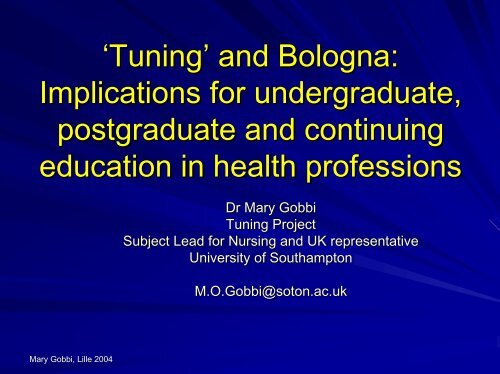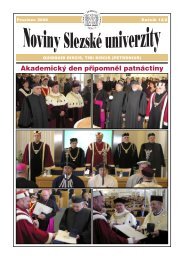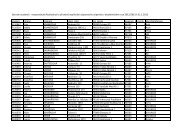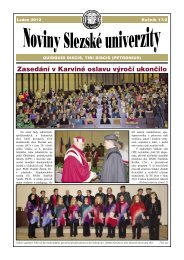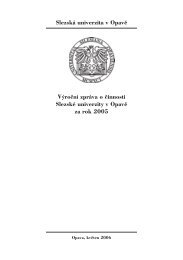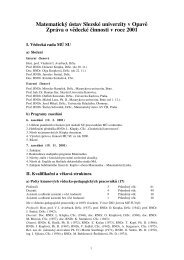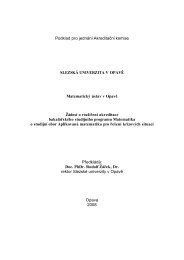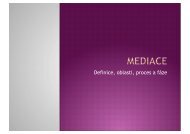'Tuning' and Bologna: Implications for undergraduate, postgraduate ...
'Tuning' and Bologna: Implications for undergraduate, postgraduate ...
'Tuning' and Bologna: Implications for undergraduate, postgraduate ...
- No tags were found...
Create successful ePaper yourself
Turn your PDF publications into a flip-book with our unique Google optimized e-Paper software.
‘Tuning’ <strong>and</strong> <strong>Bologna</strong>:<strong>Implications</strong> <strong>for</strong> <strong>undergraduate</strong>,<strong>postgraduate</strong> <strong>and</strong> continuingeducation in health professionsDr Mary GobbiTuning ProjectSubject Lead <strong>for</strong> Nursing <strong>and</strong> UK representativeUniversity of SouthamptonM.O.Gobbi@soton.ac.ukMary Gobbi, Lille 2004
Aim of PresentationSummarise the basic principles of theTUNING project in the context of <strong>Bologna</strong>Outline the issues facing health careeducation especially at graduate/bachelors/first cycle levelConsider the example of nursing as a nongraduate occupation with a GeneralDirective
The TUNING project is a project by <strong>and</strong> <strong>for</strong> universities.It is the Universities’ response to the challenge of the<strong>Bologna</strong> DeclarationTUNING MOTTOTuning of educational structures <strong>and</strong> programmes onthe basis of diversity <strong>and</strong> autonomyInitiated by Universities of Groningen <strong>and</strong> Deusto
Tuning MethodologyLearning outcomes <strong>and</strong> competencesGeneral tendencies in Higher EducationShift of paradigm: moving from a staff orientedapproach to a student centred approachLess specialised academic education in the firstcycleMore flexibility in first <strong>and</strong> second cycle programmesWhat should a student know, underst<strong>and</strong> <strong>and</strong> be ableto do to be employable?
<strong>Bologna</strong> Key points1. Adoption of a system of easily readable <strong>and</strong>comparable degrees2. Adoption of a system essentially based on two cycles3. Establishment of a system of credits4. Promotion of mobility5. Promotion of European co-operation operation in qualityassurance6. Promotion of the European dimension in highereducation7. Lifelong learning8. Higher education institutions <strong>and</strong> students9. Promoting the attractiveness of the European HigherEducation Area10. Doctoral level introduced Berlin 2003 (third cycle).
A methodology <strong>for</strong> designing,planning<strong>and</strong> implementing curriculaTuning approach:student centreddefinition of academic <strong>and</strong> professional profilesdefinition of learning outcomesidentifying generic <strong>and</strong> subject specificcompetencesoutput oriented curriculaTuning methodology <strong>and</strong> model:appropriate <strong>for</strong> mono-disciplinary, inter- <strong>and</strong>multidisciplinary, integrated <strong>and</strong> joint degreeprogrammesvalid <strong>for</strong> graduates with a wide range of profilesfocus on competences
TUNINGFocuses on the development of generic <strong>and</strong>subject specific competences which act ascommon reference pointsRespects diversity <strong>and</strong> autonomyInvolves stakeholdersMethodological approach comprising 5 lines:Line 1: Generic competencesLine 2: Subject specific competences(knowledge, underst<strong>and</strong>ing <strong>and</strong> skills)Line 3: ECTS as a European credit accumulationsystem: new perspectivesLine 4: Mapping of approaches to teaching /learning <strong>and</strong> assessment in different countriesLine 5: Quality enhancement
TUNING ANDNURSINGTo implement the <strong>Bologna</strong> - Prague - Berlin processon university level: we are the first regulated groupTo find ways to implement two cycles (now three) ina practice based professionTo identify common reference points from discipline<strong>and</strong> university perspectiveTo develop professional profiles <strong>and</strong> comparable<strong>and</strong> compatible learning outcomes <strong>for</strong> nursingTo facilitate employability by promotingtransparency in educational structures (easilyreadable <strong>and</strong> comparable degrees)To develop a common language which is understoodby all stakeholders (Higher education sector,employers, regulators, , professional bodies <strong>and</strong>users of service)
The Tuning Methodology appliedLine 1: Generic competencesThese were developed in Phase 1 through stakeholder survey.When applied to nursing, ‘application to practice’ <strong>and</strong> ‘ethicalcommitment’ were the highest ranked competencesLine 2: Subject specific competences (knowledge,underst<strong>and</strong>ing <strong>and</strong> skills)Through the mapping of the subject area, common reference pointsare established <strong>for</strong> subject specific competences. Please comment.Line 3: ECTS as a European credit accumulation system: newperspectivesDevelopment of ECTS as a tool <strong>for</strong> programme design: basis isstudent workload measured in time. How to apply to nursing/healthcare professions?Line 4: Mapping of approaches to teaching / learning <strong>and</strong>assessment in different countries - <strong>for</strong> health care groupsLine 5: Quality enhancement- to include practice based learningThe clinical learning environment makes us different
European Credit <strong>and</strong> TransferSystemStudent centred system based onstudent workload required to achievethe objectives of the programme(preferably expressed in terms oflearning outcomes <strong>and</strong> competences).The principle of Credit Accumulation isintegral to this approach.
Workload of creditsBased on convention that 60 credits measurethe workload of a full time student duringone academic year. In most cases in EU thisequates to 36/40 weeks per year.I credit = 25-30 working hours (1500-18001800hours)75 credits are considered the norm <strong>for</strong> a oneyear full time masters degree where thestudent ‘attends’ <strong>for</strong> longer.? Some health professions may constitutean exceptional case?
Health profession challengesNot all health professions aregraduate/bachelors level across European AreaEducation is not always University orPolytechnic basedSome are regulated by General Directives thattend to specify content of course <strong>and</strong> number ofhours. Most were designed in mid 1970s <strong>and</strong>reflect thisThose without General Directives have issuesrelated to freedom of movementCountries differ in their scope of practice,work<strong>for</strong>ce composition, resources <strong>and</strong>educational levels <strong>for</strong> licence/registration
Nursing ChallengesEU Directive (see Conseleg:1977L0453) specified hours,no competences <strong>and</strong> no academic level.– National <strong>and</strong> professional regulation– Registered/ licence to practice Nurse Education nottied to first cycle ‘bachelors’ degreeNo commonly agreed competences, especially at higherlevels: (ICN, WHO, St<strong>and</strong>ing Committee)Few established <strong>and</strong> operating networks to accessUniversities <strong>and</strong> other stakeholdersLabour market conditions <strong>and</strong> employer dem<strong>and</strong>s(health /social care, private <strong>and</strong> public providers)
Differences between Members States• First cycle is sometimes not requirement <strong>for</strong>registration/licence (irrespective of EUDirectives)• Different stages of academic development ofthe profession/occupation• Different histories <strong>for</strong>:• Role of practitioner (<strong>and</strong> sometimes women)• Scope of practice• Employability requirements different• Resource allocation to health care <strong>and</strong>work<strong>for</strong>ce
Decision of Nursing GroupUnanimously agreed to apply TUNING:To first cycle degree with professionalnurse registrationTo second cycle degree associated withpracticeTo establish mechanisms <strong>for</strong> dialogueconcerning EU DirectiveTo liaise with the thematic network (inprogress)
Levels of complexity <strong>and</strong>competence‘Ability to undertake comprehensive <strong>and</strong> systematicassessments using the tools/frameworks appropriate tothe patient/client taking into account relevant physical,social, cultural, psychological, spiritual <strong>and</strong> environmentfactors.’ This includes being able to:Assess normal health (theory <strong>and</strong> practice)Effectively use assessment <strong>and</strong> measurement toolsUse, <strong>and</strong> is sensitive to, cultural knowledgeDemonstrate good interpersonal <strong>and</strong> communicationskills in written, (non) linguistic <strong>and</strong> in<strong>for</strong>matic mediaAssess <strong>and</strong> diagnose/refer deviation from normal
<strong>Implications</strong> <strong>for</strong>professional profile Profession in transition (what is desirabletoday may become a requirement tomorrow) Some health care programmes are directentry in some countries <strong>and</strong> not in others (e.g.Midwifery) Multidisciplinary agenda in Health Caremeans more first <strong>and</strong> particularly secondcycle programmes are shared with others
Issues <strong>for</strong> debate <strong>and</strong>discussionViews on the nursing competencesthemselves (please <strong>for</strong>ward comments)Perspectives on ECTS <strong>and</strong> its application tonursing.Should we specify the nos of ECTS percompetence? (No) Level descriptors? (yes)!Level of nursing below RN with first cycleThe impact of <strong>Bologna</strong>: first cycle is entry intothe labour market. How does this match withsecond cycle qualifications with registration<strong>and</strong> an increasingly graduate work<strong>for</strong>ce?
Websites:http://europa.eu.int/comm/education/socrates/TuningProjecthttp://www.relint.deusto.es/TuningProject/index.htmhttp://www.let.rug.nl/TuningProject/index.htmM.O.Gobbi@soton.ac.uk


